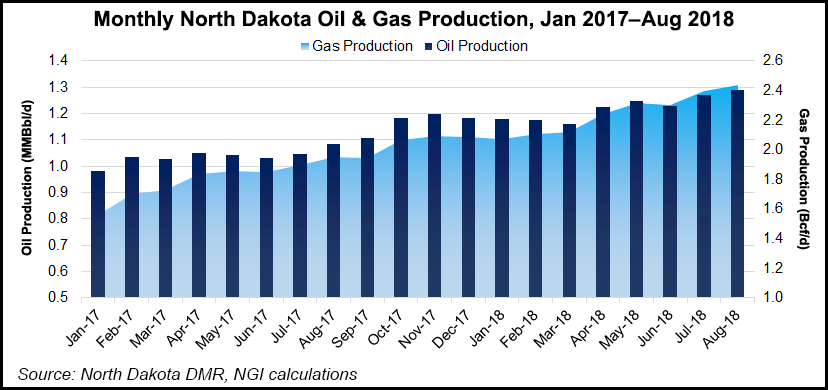Shale Daily | Bakken Shale | E&P | NGI All News Access
North Dakota Oil, Gas Production Continues Record-Breaking Pace
North Dakota’s Bakken Shale set back-to-back records for oil and natural gas production in August, the most recent month for which there are complete statistics, state regulators said Friday.

“There is a lot of good news for North Dakota in the latest numbers, and weather was near perfect in August with no heavy winds or rain,” said state Department of Mineral Resources Director Lynn Helms.
Monthly oil production in August topped 40 million bbl (1.29 million b/d), a 22,000 b/d increase month/month, compared to 39.3 million bbl (1.26 million b/d) in July. Natural gas production for August rose in tandem with oil at about 1.8%, reaching 75.5 Bcf (2.43 Bcf/d), compared to 74.2 Bcf (2.39 Bcf/d) in July.
While reaching a new high of 15,103 producing wells in August, the state topped the 40 million bbl and 75 Bcf thresholds for the first time, said Helms, who noted that the Bakken rig count on Friday reached 67 and operators are expecting that number to hit 70 by the end of the year.
The best of North Dakota’s latest “good news,” according to Helms, is the fact that there are now 45 crews conducting hydraulic fracturing (fracking). “Rig counts historically are used as indicators of production, but the number of frack crews is an even better indicator.”
Among all the record-setting statistics, he said August numbers on gas flaring remained depressed, particularly on Fort Berthold reservation lands. The statewide gas capture rate was 82% (limited to the Bakken, 83%), while Fort Berthold was 73%.
Driving the Native American reservation’s lower number is the fact that it accounted for two-thirds of the oil production increase in August (17,000 b/d of the 22,000 b/d overall increase).
“Flaring is going to be an issue continuously for the next couple of years,” said Helms, noting that the state Industrial Commission will take up the issue at its meeting later this month (Oct. 25) in anticipation of the November goal of 88% not being achieved this year.
Helms said the U.S. Bureau of Land Management (BLM) flaring and venting rules issued last month giving states and tribes control should help Fort Berthold. “It is a great revision to the rule, and I think it is going to be very helpful.”
Another piece of “good news” is the opening of a 200 MMcf/d addition to the Oasis Petroleum Corp. midstream unit’s Wild Basin plant. It will be the only significant addition to processing capacity in the Bakken until 2Q2019. “So we go into winter as we stand today, and that is going to create a real tug-of-war among gas capture, drilling rig counts and well completions.” Helms said North Dakota’s gas capture requirements set four years ago were what drove the investment by Oasis, motivating the exploration and production company to get into the midstream business.
© 2024 Natural Gas Intelligence. All rights reserved.
ISSN © 2577-9877 | ISSN © 2158-8023 |
